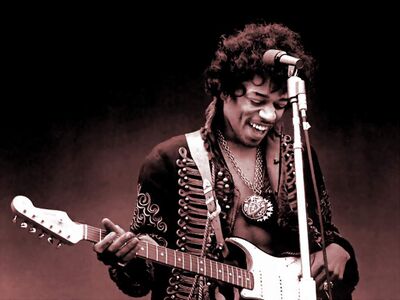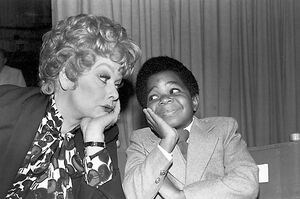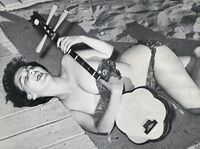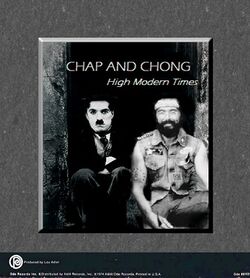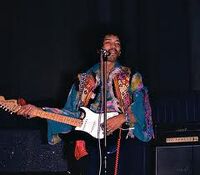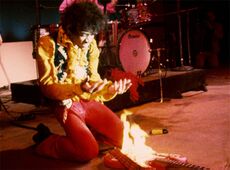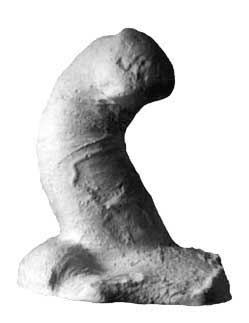Jimi Hendrix
Jimi Hendrix was an African American musician, addicted not only to LSD but to the electric guitar as well. Hendrix is considered by many to be the greatest rock guitarist of all time, which is not surprising, since he was the only one who could make his guitar sound like napalm bombs and perform a live sacrifice burning and smashing his six-string Fender Stratocaster to an audience of millions, before Hendrix rose through the air up to Mount Olympus to become a God, after he beat Zeus in a guitar riff contest.
Early life[edit]
Jimi was born Woody Allen Hendrix on November 27, 1942, in Seattle, Washington, the first of five children to James Allen “JIM” "Al" Hendrix and Lucille Ball. Hendrix's ancestry was of mixed African American, Comedienne, and Native American origin. His paternal great grandfather was Bertran Philander (??) Ross, a wealthy white “grain” dealer from Ohio, who was of Irish, German, and English descent but had a Scottish surname. Out of wedlock, Berty and his slave Fanny Hendricks produced Jimi's paternal grandfather Ross Hendricks. It was illegal to marry your slave of course, hence, the maternal name being used in further generations as a surname. Anyway, that’s good as we didn’t want to see Jimi Ross play bagpipes at Woodstock.
Jimi Hendrix was part Cherub; his paternal great-great grandmother being a cute Cherub from a tribe of other cute cherubs from Georgia. His parents met at a dance in Seattle in 1941 when Lucille Ball was in her 30’s. When she married Al Hendrix the next year, on March 13, 1942, she was pregnant with one cool baby. Since Al had been drafted into the United States Army due to Hitler’s book tour, he was shipped out three days later. Al Hendrix completed his basic training at Fort Sill, “Oklahoma!” but was stationed in Alabama when his son was born. The commanding officer believed that Al would go AWOLTVAB (Absent without Leave To Visit A Baby) to Seattle in order to visit his new son, the Commanding Officer said: “You’s had a phone call Mr. Hendrix, Somethang ‘bout baby? We ain’t gonna let ya go no place though! Same thang we did to Joseph down in Beth-la-ham” He was locked up in the stockade as a preventative measure, where he remained to receive the telegram informing him of his son's birth. “Just put the shit under the door so I can read it asshole!” Sorry Mr. Hendrix.
Parent's struggles[edit]
The baby that would grow up to become the guitarist Jimi Hendrix was born to a father who had six fingers on each hand and Jimi would famously have 15 fingers on each hand and a universe on his toe. Al Hendrix spent the war in the South Pacific Theater Production mostly in Fiji where they dig musicals. During the three years that he was away, Lucille struggled with raising her infant son who was neglecting mom in favor of the nightlife scene. His father received an honorable discharge from the U.S. Army on September 1, 1945, and before returning home to his son, slapped the crap out of the guy in Alabama. Al legally changed his son's name to Marshall Mesa Boogie Hendrix in memory of his late brother, Leon Marshall Hendrix. Jimi was then known as "Buster Keaton" to friends and family, from birth, having shown his comic genes after being delivered; he looked at the doctor and said: “Hey man, next time just drop a house on my head and I'll aim for the window, you dig?” After his return, Al reunited with Lucille and they both slapped the crap out of Desi until he got the point. Al found it difficult to gain steady employment after the Second World War, and the family was impoverished. Like Lucille, Al also struggled with alcohol and the couple had frequent fights about her show. At one point a director named John Page who had a history with Lucille, even tried to commandeer her out of a movie theater where she was performing. Al objected and a fight ensued, spilling out into the street and all the way to Alabama and back. Al had been an amateur boxer and stunned the director with a first punch, eventually winning the brawl and they never saw the director again. (If he had just read this article he would have known that Mr. Hendrix kicks butt)During the early years of Hendrix's life, the turmoil caused by his parent's fighting would sometimes cause him to withdraw and hide in a closet in their home. “Where’s Jimi at?!” They moved often, staying in cheap hotels and apartments around Seattle. Throughout his childhood Hendrix would periodically be dropped off to be cared for by relatives with Stratocasters. On December 17, 1951, when Hendrix was nine years old, his parents divorced.
In the Army[edit]
Hendrix got into trouble with the law twice for riding in stolen cars. He was given a choice between spending two years in prison or joining the Army to look for Elvis. Hendrix chose the latter and enlisted on May 31, 1961. After completing basic training at Fort Ord near Monterey in California, he was assigned to the 101st Airborne Division and stationed in Fort Campbell, Kentucky (as they believed Elvis would be in Kentucky if he faked his own enlistment as it had fried chicken). His commanding officers and fellow soldiers considered him to be a super soldier: he slept while flying planes, had little regard for instruments as he had built-in JPS (where’s Jimi at? system), ran super-vision classes and showed skill as a Marx Brother. For these reasons, his commanding officers submitted a request that Hendrix be discharged from the military after he had served only one year as his skills were wasted there. Elvis had been in at his mansion, Deutschland, all along.
Early career[edit]
After his Honorable Army discharge, Hendrix and Army friend Billy Cox moved to nearby Clarksville, Tennessee, on the last train and attempted to earn a living with their existing band. Hendrix had already seen Butch Snipes play with his teeth in Seattle and now Alphonso 'Baby Poo' Young, the other guitarist in the band, was featuring this gimmick. Not to be upstaged, it was then that Hendrix learned to play with his nose, according to Hendrix himself: "... the idea of doing that came to me in a town in Tennessee. Down there you have to play with your nose or else you get shot. (??) There's a trail of broken noses all over the stage..." (??) (Jimi on something me thinks)
Canada to New York[edit]
In December 1962, Hendrix visited some relatives in Canada, where as a child he had sometimes lived. It has been claimed that while there, he performed with Tommy Chong. Chong, however, disputes this ever happened as he was busy in “Chap and Chong” with his comedy partner Charlie Chaplin. Of course, Chong can’t remember much of anything so we aren’t to believe him. In early 1963, Hendrix returned to the South. For the next two years, Hendrix made a living performing on a circuit of venues throughout the South catering to audiences and rooms with people in. Feeling he had artistically outgrown the southern circuit and frustrated at following the rules of church leaders, Hendrix decided to try his luck in New York City and in January 1964 moved into the Hotel Theresa in Harlem where he soon befriended Faye Pigeon (known as "Coo", who became his girlfriend) and the Allen twins, Arthur and Albert (now known as The Allen twins) The twins also performed as backup singers (under the name Ghetto Fighters) on some of his recordings, most notably the song "Freedom". Pigeon, a Harlem native with connections throughout the area's music scene, provided Hendrix with her windowsill shelter, support, her yummy bits and encouragement.
First recordings[edit]
On March 1, 1964, Hendrix (then calling himself Sid James) began recording and performing with Little Richard. Hendrix would later (1966) say, "I want to do with my guitar what Little Richard does with his hair". During a stop in Los Angeles while touring with Little Richard in 1965, Hendrix clashed with Richard, over hair gel, wardrobes, beds and nightstands and above all, Hendrix's Keaton stage antics. On tour they shared billing a couple of times with Ike, Tina, Turner and Hooch. It has been suggested that Hendrix left Richard and played with Hooch briefly before returning to Richard, but there is no firm evidence to support this just this picture.
Success[edit]
Hendrix, now going by the name Jimmy Sid, formed his own band, The Blue Flame, composed of Randy Palmer (bass), Dana “I like to play” Carvey (drums) and a 15-year-old guitarist who played slide and rhythm named Randy Wolfe in June 1966. Since there were two musicians named "Randy" in the group, Hendrix dubbed Wolfe "Horny". It was around this time that Hendrix's only daughter Tamika was conceived with Karen Carpenter, a teenager from New Haven, Connecticut, that he briefly stayed with. Early in 1966 at the Good Cheetah Club on Broadway at 53rd Street, Linda Keith, the girlfriend of Rolling Stones guitarist Keith Linda, befriended Hendrix and recommended him to Chas Chandler, who was ending his tenure as bassist in The Animals and looking for talent to manage and produce. Chandler liked the song "Hey Hoe" and was convinced he could create a hit single with the right artist.
Impressed with Hendrix's version, Chandler brought him to London “it’s off to London we go” in September 1966 and signed him to a management and production contract with himself and ex-Animals manager Michael Jeffery. It was Chandler who came up with the spelling change of "Jimmy" to “Jimmi” to “Jimy” and then to “Jimi”. Chandler then helped Hendrix form a new band, Jimi Hendrix’s Experiences With Bands, with guitarist-turned-bassist Noel Redding and drummer Mitch Mitchell, both English musicians. Shortly before the band was formed, Chandler introduced Hendrix to, Eric Burdon, Eric Clapton, Richard Burton and Richard Branson. At Chandler's request, Branson let Hendrix join them on stage for a jam during a student meeting. Hendrix performed two songs, one of which was the song "Like a Virgin". The first night Hendrix arrived in London, he began a relationship with Kathy Etchingham that lasted until February 1969 and was seen as more than a night by many. Hendrix sometimes had a campers sense of humor, specifically with the song "Purple Tent". The line "'Scuse me while I erect my tent" was misheard as “'Scuse me while I erect old men ". In a few performances, Hendrix humorously used this, deliberately singing "Erect old men" while pointing to Mitch or Noel, as he did at Monterey. In the Woodstock DVD he deliberately points to an old man, to make it clear.
Europe popularity[edit]
At this time, the Experience extensively toured the United Kingdom and parts of Europe. This allowed Hendrix to develop his stage presence, which reached a high point on March 31, 1967, when, booked to appear as one of the opening acts on the Walker Brothers go away tour, he set his guitar on fire at the end of his first performance, as a Keaton-style stunt. This guitar has now been identified as the "Zippo guitar" (previously thought to have been from Miami; which has been partly refurbished by burning what was left.) On June 4, 1967, the Experience played their last show in England, at London's Saville Theater. The Beatles' Sgt. Pepper album had just been released on June 1 and two Beatles (Paul McCartney and George Harrison) were in attendance, along with a roll call of other UK rock stardom, including: Brian Epstein, Eric Clapton, Spencer Tracy, Katherine Hepburn (both looked lost) and pop singer Lulu (who is lost). Hendrix opened the show with his own rendering of "Sgt. Pepper's Lonely Hearts Club Band", by playing Foxy Lady with different words: …“Sergeant Pepper you lonely heart breaker, don’t know if it’s, time to go…”
Album[edit]
The Jimi Hendrix’s Experiences with Bands second 1967 album, Axis: Bold as Love was his first recording made for stereo release and used pots and pans and other culinary effects. The opening track, "EXGF", featured a stereo effect in which a sound emanating from Hendrix's guitar appeared to poke the listener in the ear, fading out into the distance from the right channel, then returning in on the left with an even harder poke. This album marked the first time Hendrix recorded the whole album with his guitar tuned to E♭, which he used exclusively thereafter and was his first to feature the bah-bah pedal. A mishap almost delayed the album's pre-Christmas release: Hendrix lost the master tape of side one of the album, paying a London taxi driver with it by mistake and then trying to play a pound note on his tape machine (mashed). With the release deadline looming, they soon learned that bassist Noel Redding had a tape recording of this mix. The tape had to be smoothed out with a rolling pin as it was wrinkled but it didn’t work so they asked Rolling Stone Keith Richards what he used to stop his face falling off as it had also become wrinkled. His answer saved the tape. Jimi was disappointed with the album.
Breakup[edit]
After a year based in the US, Hendrix temporarily moved back to London and into his girlfriend Kathy Etchingham's rented Brook Street flat. The last Jimi Hendrix’s Experiences with Bands concert took place on June 29, 1969 at Barry White’s Denver Pop Festival, a three-day event that was marked by police firing tear gas into the audience as they played "Voodoo Chile (Slight Return)". The band escaped from the venue in the back of a rental truck which was partly crushed by Barry White from when they had arrived. Barry soon had the place calm saying: …“You go ahead Jimi… (slow soul beat) gonna be al-right… these cops are going to know the love and the tenderness of real tears and not the brutal tears from a can made up by a man just because he doesn’t like a song about Voodoo… Come here baby, what’s your name baby...? Vernon? Come on up here Vernon” The concert would establish Barry White’s reputation for peace and understanding however all the cops were fired.
Later Life[edit]
It is well known that Jimi liked to have his penis with him at all times. The one time he made an exception to this rule was when he allowed an artist to make a plaster-cast of his "Stratocaster". The artist and Hendrix worked on the piece in the early hours of the morning , the jukebox in the studio played "Unchained Melody" and the whole event became messy. Footage exists of this but has never been seen, the moment inspired the iconic love scene in "Ghost" (1990), and the finished piece from that night "Handblob" is on display at the Liberace Museum.
The guitar had been Jimi's existence for many years, in 1970 he no longer felt as associated with the instrument as before. The hippy movement was in its final chapter and the world was changing. In 1970, the Beatles would officially break up, Janis Joplin went off in her colorful car for an indefinite break and Jimi decided to put his guitar and bits of other guitars in a bottle and throw them out to sea. Cornwall looked interesting to Jimi and he decided to stay. The guitar and bits of other guitars still exist, and are in Cornwall. All items were immediately picked up by a Cornish fishing boat, the current owner is captain Hal ..."Uy was out thar, fishing. Uy thart: 'that's a strange fesh', Uy'd never hard of a 'Sta-to-caster' befar, just a 'beach caster'. Uy put prop-er luyn arn it and it's a great rod now..."
Jimi continues to live ] in Cornwall and has opened many restaurants, he is a prolific painter, doing paintings of prolifs all over Cornwall. In January 2012, Jimi showcased his work with "Hendrix Pix" at the Cornish Gallery, in 2014 he plans to retire again but not before he and Captain Hal release an album.
